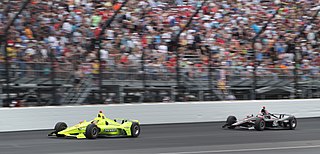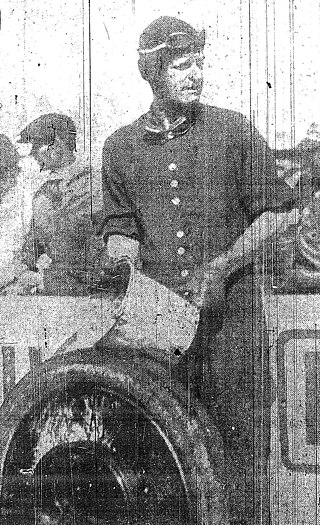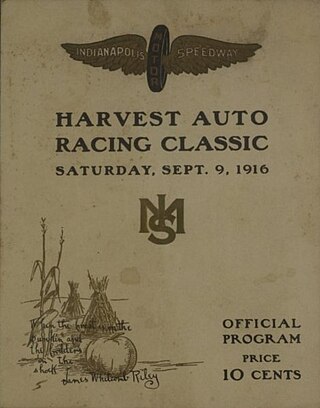
The United States Grand Prix is a motor racing event that has been held on and off since 1908, when it was known as the American Grand Prize. The Grand Prix later became part of the Formula One World Championship. As of 2023, the Grand Prix has been held 52 times at ten different locations. Since 2012, it has been held every year at the Circuit of the Americas in Austin, Texas, except in 2020 when it was cancelled due to the COVID-19 pandemic.

James Anthony "Jimmy" Murphy was an American race car driver who won the 1921 French Grand Prix, the 1922 Indianapolis 500, and the American Racing Championship in 1922 and 1924.

American open-wheel car racing, also known as Indy car racing, is a category of professional automobile racing in the United States. As of 2022, the top-level American open-wheel racing championship is sanctioned by IndyCar.

Dario Raoul Resta, was a British racing driver. He is best remembered for his successes racing Indy cars in the United States. The 1916 American National Champion, Resta was the winner of the 1916 Indianapolis 500, as well as the Vanderbilt Cup in 1915 and 1916.

The 6th International 300-Mile Sweepstakes Race was the sixth running of the Indianapolis 500. It was held at the Indianapolis Motor Speedway on Tuesday, May 30, 1916. The management scheduled the race for 120 laps, 300 miles (480 km), the only Indianapolis 500 scheduled for less than 500 miles (800 km).

The 7th Liberty 500-Mile Sweepstakes was held at the Indianapolis Motor Speedway on Saturday, May 31, 1919.

John Donald Aitken was an American racing driver from Indianapolis, who was active in the years prior to World War I. Aitken competed in the Indianapolis 500 three times. He started the race twice, in 1911 and 1916. He led the first lap of the first race (1911). Aitken captured the pole position in 1916, but ended up in 15th place that year. In the 1915 Indianapolis 500, Aitken drove relief for two drivers, Gil Anderson and Earl Cooper.

The Astor Cup Race was an American auto racing event, first run in 1915 at the Sheepshead Bay Speedway at Sheepshead Bay, New York. The winner's trophy was donated by Vincent Astor, whose name and connections ensured the attendance of members of New York City's fashionable and wealthy elite.

Russell Snowberger was an American racecar driver and owner active from the 1920s through the 1950s. After his lengthy Indianapolis career, Snowberger continued his affiliation with the "500" by sponsoring entries throughout the 1950s.
The 1911 Grand Prix season consisted of Grand Prix races in the United States and Europe. It was a significant year as European racing gradually came out of the doldrums. A Grand Prix was held in France again. The first Indianapolis 500 was held at Indianapolis Motor Speedway, joining the American Grand Prize as a leading race.

The 1914 Grand Prix season consisted of Grand Prix races across Europe and the United States until abbreviated by the outbreak of World War I.
The 1915 Grand Prix season saw Grand Prix motor racing continue in the United States. Racing was suspended in Europe due to the outbreak of World War I. The American Grand Prize was held in San Francisco for the first time, in conjunction with the Panama–Pacific International Exposition. Several of the latest European cars had been imported to the USA before the war started. Briton Dario Resta had a Peugeot and Ralph DePalma raced one of the Mercedes GPs. While Resta won both races at San Francisco and DePalma won the Indianapolis 500, just ahead of Resta it was Earl Cooper, running a Stutz, whose consistency gave him the unofficial AAA national championship.
The 1916 Grand Prix season saw Grand Prix motor racing continue in the United States. Racing was suspended in Europe due to the World War I engulfing the continent. Once again European cars dominated Indianapolis with victory going to Briton Dario Resta in a Peugeot. With the organisers wanting to appeal to the spectators, this was the only year that the race was scheduled for a shorter length – to run only 300 miles. The Vanderbilt Cup and the American Grand Prize returned to Santa Monica, California at the end of the year. Resta repeated his victory from the year before, winning the Vanderbilt Cup. Then when he retired in the Grand Prize it was Howdy Wilcox and Johnny Aitken who won in another of the dominant Peugeots. Oval courses now dominated the AAA Championship with these two events being the only road-course races this year. It proved to be the final time these two formative American races were held in this format, as the Great War dragged the country into the global chaos in 1917.

The 1923 Grand Prix season was part of a watershed year for motor racing that saw significant advances in motor-racing engineering, design and events. Fiat's chief designer, Guido Fornaca, developed the 805, the first supercharged car to win a Grand Prix. Benz appeared with the first mid-engined racer and, along with Bugatti and Voisin, produced some of the first efforts at aerodynamics on racing cars. With the United States also adopting the 2-litre formula, Harry Miller could use the smaller engine size to design the first single-seater race-car, ideally suited to American oval racing.

The Harvest Auto Racing Classic was a series of three automobile races held at the Indianapolis Motor Speedway on Saturday September 9, 1916. The meet, held four months after the 1916 Indianapolis 500, featured a 20-mile race, a 50-mile race, and a 100-mile race. The main event, a 100-mile Championship Car race, paid points towards the 1916 AAA National Championship. Johnny Aitken won all three races, two of which had a margin of victory of less than a car length.
The 1919 Grand Prix season was the first season following the armistice that ended World War I in November 1918. European economies were struggling, and many automotive firms had to recover and retool from military production. So, there was very little racing activity as it took time for the companies and populations to recover. As the world rebuilt there were only two major races held in the year – the Indianapolis 500 and the Targa Florio.
The 1920 Grand Prix season saw further activity in motor-racing gradually increase. Europe was still recovering from the end of the war and the terrible pandemic that swept the continent. Automotive companies were gradually re-establishing themselves after re-tooling from a wartime footing and getting production lines rolling again.
The AAA Contest Board was the motorsports arm of the American Automobile Association. The contest board sanctioned automobile races from 1904 until 1955, establishing American Championship car racing. Modern-day IndyCar racing traces its roots directly to these AAA events.
The 1946 AAA Championship Car season was the first season of American Championship car racing following World War II. After four years without racing in the United States, the AAA Contest Board was initially concerned about having enough races, enough entrants, and suitable equipment, for a 1946 season. Even the Indianapolis 500 was in doubt, as the Indianapolis Motor Speedway had been neglected during the war.












